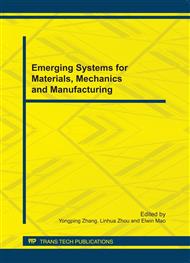[1]
J.R. Norris, L.C.G. Rogers and D. Williams, Self-avoiding random walk: a Brownian motion model with local time drift, Prob. Theory. Rel. Fields, 74 (1987) 271-287.
DOI: 10.1007/bf00569993
Google Scholar
[2]
R.T. Durrett and L.C.G. Rogers, Asymptotic behaviour of Brownian polymers, Prob. Theo. Rel. Fields, 92(1992) 337-349.
DOI: 10.1007/bf01300560
Google Scholar
[3]
M. Cranston, Y. L. Jan, Self-attracting diffusions: two case studies, Math. Ann. 303(1995) 87-93.
DOI: 10.1007/bf01460980
Google Scholar
[4]
R. Pemantle, A survey of random processes with reinforcement, Prob. Surveys 4(2007) 1- 79.
Google Scholar
[5]
Anna C. Balazs, Challenges in polymer science: controlling vesicle-substrate interactions, Journal of Polymer Science: Part B: Polymer Physics, 43(2005) 3357-3360.
DOI: 10.1002/polb.20635
Google Scholar
[6]
P. Abbott, N. Brooks, W. Eltringham, A. Robert Hillman, and Eric G. Hope, Polymer modification using difluoromethane (HFC 32) and carbon dioxide, Inc. J Polym Sci Part B: Polym Phys. 44(2006) 1072-1083.
DOI: 10.1002/polb.20762
Google Scholar
[7]
Vasantha M. Datla, E. Shim, and B. Pourdeyhimi, Polypropylene surface modification with stearyl alcohol ethoxylates to enhance wettability, J Appl Polym Sci. 121 (2011) 1335-1347.
DOI: 10.1002/app.31051
Google Scholar
[8]
M. Sjöqvist and A. Boldizar, Molecular modification and compatibilization of collected polyethylene, J Polym Environ., 19(2011) 335-340.
DOI: 10.1007/s10924-010-0277-x
Google Scholar
[9]
K. Kita, N. Kondo, H. Hyuga, Y. Izutsu and H. Kita, Study of modification on alumina surface by using of organosilicon polymer, Journal of the Ceramic Society of Japan, 119(2011) 378-381.
DOI: 10.2109/jcersj2.119.378
Google Scholar
[10]
S. Roy, Chee Yoon Yue, Surface modification of COC microfluidic devices: A comparative study of nitrogen plasma treatment and its advantages over argon and oxygen plasma treatments, Plasma Process. Polym., 8(2011) 432-443.
DOI: 10.1002/ppap.201000120
Google Scholar
[11]
W.J. Yoon, Y.S. Kim, I. S. Kim and K. Y. Choi, Recent advances in polymer reaction engineering: modeling and control of polymer Properties, Korean J. Chem. Eng., 21 (2004) 147-167.
DOI: 10.1007/bf02705393
Google Scholar
[12]
J.D. Halverson, W. B. Lee, Gary S. Grest, A. Y. Grosberg, and K. Kremer, Molecular dynamics simulation study of nonconcatenated ring polymers in a melt. II. Dynamics, The Journal of Chemical Physics, 134 (2011) 204905.
DOI: 10.1063/1.3587138
Google Scholar
[13]
Y. Oaki, M. Kijima, and H. Imai, Synthesis and Morphogenesis of Organic Polymer Materials with Hierarchical Structures in Biominerals, J. Am. Chem. Soc. 133 (2011) 8594-8599.
DOI: 10.1021/ja200149u
Google Scholar
[14]
Christian J. Cyron and Wolfgang A. Wall, Consistent finite-element approach to Brownian polymer dynamics with anisotropic friction, Physical Review E 82 (2010), 066705.
DOI: 10.1103/physreve.82.066705
Google Scholar


